https://www.facebook.com/Permasystems/
|
After finally finding some time to work a little on the cob cabin we continued to construct the porch roof by installing the horizontal roof support made out of a used telephone pole, a few joists, and also part of the roof to protect the cob from rain.
Like our Facebook page to be notified of new blog posts and videos.
https://www.facebook.com/Permasystems/
1 Comment
In this series we highlight various plants we find to regeneratively suit dryland ecosystems. Our experience is based on plantings at our permaculture education and demonstration site in Ramona, CA. We are a Mediterranean climate, Zone 9, with approximate annual rainfall of 16 inches. Soil at the site is variable. Habitat is primarily chaparral with some grassland and oak woodland.
The pomegranate is native from Iran to the Himalayas in northern India and was grown in the Mediterranean region since ancient times. It is widely cultivated in India and the drier parts of southeast Asia, Malaya, the East Indies and tropical Africa. The plant was introduced into California by Spanish settlers in 1769. In this country it is grown for its fruits mostly in the drier parts of California and Arizona.
The pomegranate is a neat, rounded shrub or small tree that can grow 20 or 30 ft., but more often 12 to 16 ft. tall. There are also dwarf varieties. It is usually deciduous, but in certain areas the leaves will stay on the tree. Pomegranates are long-lived with specimens in Europe that are known to be over 200 years of age! They can be pruned into trees but will try to grow more like bushes by sending out lots of suckers from the base. There are over 500 named pomegranate cultivars! Pomegranates provide healthy doses of vitamin C, vitamin K and folate. The seeds are a rich source of dietary fiber and micronutrients. They can eaten or used in dishes fresh and raw, straight out of the peel and white pulp membrane, or turned into juice, wine, liqueur, sauce, marinade, jam, spices, cooked into an infinite variety of dishes or dried.
This easy to grow plant is relatively fast growing, extremely hardy and drought tolerant needing no supplemental water after establishment at our site. We have planted them in a range of soils and found them to grow well even in extremely hard and heavy clay soil that does not drain well.
To date we have planted the wonderful, parfiaka, kashmir bland, ambrosia, eversweet and evergreen cultivars. They all seem to be doing well. Most are less than 2 years old and have not produced much fruit so it is too soon to say which are producing best. We will give you an update in a year. Some are planted in the food forest and some just out on their own. The ones in the food forest are growing faster but I think that is because of the healthier soil in the food forest. When thoughtfully placed using permaculture (click to learn more about permaculture and ecological design), pomegranates make a wonderful addition to any food forest or ecosystem. They are so easy to grow, beautiful, provide versatile, tasty and healthy food, shade, organic matter from falling leaves and roots and are easy to chop and drop to build healthy soil. They are also super easy to propagate or can be purchased for pretty cheap in small sizes. A simple to use fruit press can easily get the juice out of pomegranates in case you are not a fan of removing the seeds!
Like our Facebook page to be notified of new blog posts!
Click here to be directed to our Facebook page
Prickly pear cactus and it's fruit have been an important food for indigenous people of the Americas for eons. The cactus pads can be eaten, and used as medicine, while the fruit, often called an apple, is a sweet and juicy treat.
Prickly pear cactus (Genus Opuntia) has literally an infinite number of species as this Genus easily and often hybridizes. Originally native to the Americas, like most true cactus species, prickly pear is now found all over the globe. In Mexico, prickly pears are often used to make appetizers, soups, and salads through entrees, vegetable dishes, and breads to desserts, beverages, candy, jelly, or drinks.
What's so cool about the prickly pear cactus is that it can provide a ton of food with zero supplemental water in a dryland ecosystem. Take a look at the photo above, this prickly pear cactus (unknown species) has been growing at our permaculture education and demonstration site in Ramona, CA for decades. It never gets a drop of supplemental water and we only get an approximate average of 15 inches of rain a year - yet every year it has tons of fruit! Check out how much fruit there is on a single pad below!
Picking the fruit from the plant should not be taken lightly. It is not hard but each pad and fruit has tons of little spines called glochids. They are small hairlike prickles that easily penetrate the skin and detach from the plant. That means good gloves and protective clothing are in order. Keep in mind that no matter how much protection you don, spines somehow always get stuck in you so have a good pair of tweezers or a pain tolerance ready. The spines don't hurt much but are so small and numerous that they can be difficult to get out of your skin and clothing.
You know the fruit is ripe when it easily detaches from the pad with a push or pull. Pick as many apples as you can, leaving some on the plant for other animals. Set your bounty in a bucket or something sturdy as they get heavy.
To process the fruit find a nice flat cutting surface that you don't mind getting stained from the beautiful juices of the apple. Some people burn off the spines or brush them off, but I find it far faster to just fillet off the skin, vastly reducing the chance of getting any spines in your food. The skin is great for composting.
Start by setting the fruit on the flat rim of one side so it stands on end and the part that separated from the pad is pointing up. Then fillet downward in sections around the apple as thinly as possible while still getting all the spines. Slice down until you are almost at the bottom, just before you hit the skin, then stop (like the photo below). Then you can either slice across the bottom horizontally or grab the slippery flesh and twist off of the skin. The best method kinda depends on the species.
Now you get to choose what to do with your yummy bounty. If this is your first time eating prickly pear apples just take a big bite as is and enjoy! The flavors can vary a lot between plants and species but hopefully they are juicy and super sweet. There are seeds in the fruit but I just try to chew them some and swallow.
As we said before, this fruit can be used for so many things but one of my favorite is just plain or in smoothies. You can make juice, wine, sorbet, syrup, or add them to just about any dish. Be creative and enjoy this amazing permaculture fruit! Please like our Facebook page to be notified of new blog posts. Link to Facebook page here.
A recent article in The San Diego Union Tribune featured Milijan Krecu, a San Diego local farmer and educator.
Milijan, originally from Yugoslavia, immigrated to the US and went to college at UC Santa Cruz where he discovered that everyone wasn't experiencing the same joy and rich flavors from food that he had grown up with. He is assistant property manager and farm advisor for the Leichtag Foundation's Leichtag Commons farm. The private and independent foundation works to support Jewish life in North County and Israel, fight poverty and advance self-sufficiency. They grow great food via Coastal Roots Farm, host events, rent out space to growers, and connect organizations. They primarily grow seasonal row crops but have a new food forest that relies on permaculture principles and techniques. We look forward to seeing their food forest grow! Link to original article here: http://www.sandiegouniontribune.com/lifestyle/people/sd-me-one-krecu-20170809-story.html Like our Facebook page to be notified of new blog posts. https://www.facebook.com/Permasystems/
This Minisode shows the progress on the roof of the cob cabin, the porch support poles and the cob wall integrated ferrocement rainwater harvesting tank.
The roof will be ferrocement, like our water tanks, consisting of 3 layers of steel lath encapsulated in cement for a total thickness of 3/8 inch (click here to see our page about ferrocement). Because the roof will be a patio we need to make it extra strong to support a lot of weight in case a lot of people go up there. To do so we are using 24 foot 2x12 rafters laid into the top of the cob walls which to the cob wall on the other side, about 18 feet. These are spaced 1 foot oc on 1 side on 16 inches oc on the other. We will pulace plywood on top of the rafters and apply the ferrocement roof on top of that. The ferrocement roof will be floating to compensate for different expansion and contraction of the wood versus cement. Small gutter-like devises will be custom integrated in the roof to convey water towards a downspout on one corner of the roof that leads to the water tank. The water tank is made out of ferrocement (click link to be directed to more information about our ferrocement water tanks) and will be integrated into one of the cob walls. This will save time and materials because we will not have to build a cob wall there while also providing a ton of thermal mass. A rocket mass heater will be built between the water tank and large integrated granite boulder inside the cob cabin. Overflow from the water thank will be directed to our food forest (click link to see blog and video about food forest). The roof will overhang approximately 12 feet to the south in a semi-circle to provide a large covered patio. This will provide passive heating and cooling including shade and shelter from the rain. We sunk 2 sections of telephone polls into the ground to support this patio roof. The poles were free from the electric company who was replacing them on our land. An additional horizontal pole will be placed on top the two vertical poles sunk in the ground to support the roof rafters. For the vertical telephone poles we dug down until we hit solid rock, about 2 feet in those 2 spots, then made a level spot in the bottom of the hole with concrete, placed a pole on that, then filled in around the poles with recycled road-base (basically crushed concrete of various sizes) ensuring it was well compacted. Please enjoy the video below.
You can click the "Cob" category on the right hand side of this page to see all previous posts about the cob cabin building project.
Please like our Facebook page to be notified of new Minisodes and blog posts! Click link to be directed to our Facebook page.
Ecological design = any form of design that minimizes environmentally destructive impacts by integrating itself with living processes (Sim Van der Ryn and Stuart Cowan). Was popularized in 1971 by Ian McHarg in his book, Design with Nature. This book describes an ecologically sound approach to the planning and design of communities. Permaculture = combines the words permanent agriculture and culture.. Coined by Bill Mollison and David Holmgren in 1978 based on the work by Masanobu Fukuoka, J. Russell Smith, P.A. Yeoman to simply be ethical, regenerative landscapes and food systems. Here at Permasystems, we use the terms permaculture and ecological design interchangeably. Work with nature, instead of against it Permaculture is an ethical design system used as lens to view the world and a toolbox to develop and maintain regenerative systems. It focuses on using regenerative energies in the ways that nature already does and connects different disciplines, strategies and techniques. Permaculture works with, benefits, and extends the patterns of nature. Ecological design and permaculture principles have been used by humans for thousands of years. Unfortunately, we have lost many of those skills that were being honed for eons. Now, we are seeing a resurgence of people bringing permaculture tools back and utilizing them for everything from growing food, to designing communities, managing waste, water and soil, building homes and other structures and much more. 
To better understand permaculture, lets take a look at a healthy tree growing in the remote mountains. It grew from a seed. This tree gets water from precipitation, no hoses. This tree gets nutrients from the soil and air, no artificial fertilizers. Soil is built from the leaves that fall off of the tree, from dead branches that break down, from bacteria and fungi living in the soil creating nutrients for plants. Nothing extra is added! It is regenerative! Now, look at a tree in your yard or neighborhood - how does it compare to our mountain tree? Is it regenerative? If not, how could we make it? Permaculture can be used at any level, from your house, to your garden, to your neighborhood, to your to city, or beyond...
Like our Facebook page to be notified of new posts.
Link to our page https://www.facebook.com/Permasystems/
See our permaculture education and demonstration site where we are building a regenerative homestead in a Mediterranean climate in eastern San Diego County. Here is an update on some amazing new plants we put in the food forest and also look at how plants from last year are doing.
Please be sure to like our Facebook page to be notified of new blog posts and videos!
Link to our page is here https://www.facebook.com/Permasystems/
We are excited to show you the results from soil testing around the cob cabin we are building. This structure is part of our ecological design (permaculture) education and demonstration site that includes the natural building made of cob (learn about cob from our blog post), a food forest (here is a blog post about some of the plants in the food forest - more information and videos to come soon), graywater systems including an outdoor shower, composting toilet, off-grid solar system and more!
Please be sure to read our previous blog post about Baseline Soil Testing before you continue. That post talks about how and why we did the testing. Remember, healthy soil holds far more water than dirt and can provide all the food plants need so you don't have to apply fertilizers or pesticides.
The results from 3 soil tests:
Comparison of select variables:
Results
As you can see from the results, most of the tested nutrients fell within "optimal levels." The majority of variables were measured in PPM (parts per million). The reports were fairly comparable and showed some consistency, for example, the Ph tests found amounts of 6.2, 6.4 and 6.7, relatively low variation. Conversely, there were a small amount of variables that had extremely high variably, for example, Maganese, measured at 10.3, 54 and 12.08, all apparently measured in PPM, the 54 number from Logan Labs is nowhere near the others. The point of these tests is NOT to use the results as a gauge to adjust our soil, but to serve as a baseline as we build soil biology. Adding more of this or that nutrient is pointless as virtually all soil on the planet contains the nutrients to support healthy plants. The problem is they are often in a form not available to plants but are locked up in dead soil. To make the nutrients available to plants we need to create soil that is alive with bacteria, fungi and other beneficial life - that can deliver nutrients to plants. We will go much further into this in future blogs. The two numbers out of these tests that we are focusing on are pH and organic matter percentage. We are very happy to hear our pH is about 6.4. This means our soil is of an ideal pH to grow both annual (bacterial dominant) and perennial (fungal dominant) plants. Being slightly on the acidic side means we have a little more ammonium than nitrate, boosting the fungal content of the soil which will provide more food for perennial plants, the type we are focusing on for the education and demonstration site. A diverse array of perennial plants can provide food year-round, perennial roots go deeper than annual so they are better able to reach water and nutrients while also building soil structure, and, they only need to be planted once. We still want some annuals though, the key is to get them self seeding so you don't spend time sowing seeds each year or at least use seeds that are easy to sow, just toss em out! Our organic matter is at about 3%, something we want to boost a lot! Probably want to shoot for at least 20%. Remember, the key to all this is building healthy soil that is alive and diverse with beneficial life! Resources To learn a lot more about soil biology from our favorite soil scientist, Elaine Ingham, visit her site at http://www.soilfoodweb.com/ Also, Matt Powers has been working with Elaine as well as doing lots of his own amazing work with Permaculture. Visit his site at http://www.thepermaculturestudent.com/ Please like our Facebook page to be notified when new blog posts come out. Link to our page https://www.facebook.com/Permasystems/
We fenced in 1/4 acre around the cob cabin. This fence serves many purposes (stacking functions). For one, we want to keep rabbits, deer and gophers out of this area. Outside the fence we planted lots of yummy things (share the surplus) for the wild animals but inside the fence we want an easy to manage safe planting zone.
The fence will also keep our little dog safe and inside. We have coyotes, foxes, bobcats and mountain lions in the area. Additionally, in the future, we will have chickens and maybe some little pigs or goats and we want them to be safe from predators as well. The fence provides structure for vines and other plants, which we are planting a lot of! This will serve as a wind break to reduce evaporation and provide additional shade. Additionally, the fence defines a fire break on both sides of the predominant wind directions. Our fence is comprised of:
The whole fence took about 7 days of work, most of those days with 2-4 people working. It should last many decades. Thanks to those that helped! Now lets grow some food!
This past week we were very excited to install a rainwater collection system at Birney Elementary School in University Heights, San Diego, CA. It included a 300 gallon ferrocement cistern (Model LFC-300) that we hand-made at our shop and then assembled on site. The catchment area is a large multi-classroom roof so they will get lots of rainwater to use for their school garden!
School gardens are extremely effective for experientially teaching kids about natural history and ecology, nutrition, water cycles, carbon cycles, soil ecology, and food cycles - not to mention what good food should taste like! They also teach kids environmental stewardship, foster a connection with nature and build practical skills. Having a rainwater harvesting tank adds an additional observable element to the garden letting kids actually see what is happening with water on site. It also saves the school money by using less water and reducing demand on stormwater drainage systems.
The rainwater from the tank will be used to water trees and plants in the garden. A garden hose attachment makes is easy to move the water around using only gravity. The tank is light proof so no algae can grow, letting water be stored as long as needed. The tank and all parts of it are potable grade to provide the highest quality water. A first-flush device (#2 in photo below) allows the first few gallons from a rain event to be diverted from the tank and back to the drain ensuring the tank water is extra clean for plants.
The kids are planning to hand paint the tank - something you can only do with cement tanks. Plastic and metal tanks flex too much so the paint would flake off. We look forward to teaching the kids about water and rainwater harvesting in upcoming classes!
Remember, just 1 inch of rain over 1000 square foot of roof equals 600 gallons of water!
Like our Facebook page to be notified when new blog posts come out.
Click to be directed to our Facebook page |
Categories
All
Archives
May 2024
|
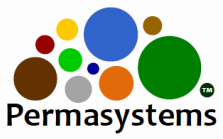

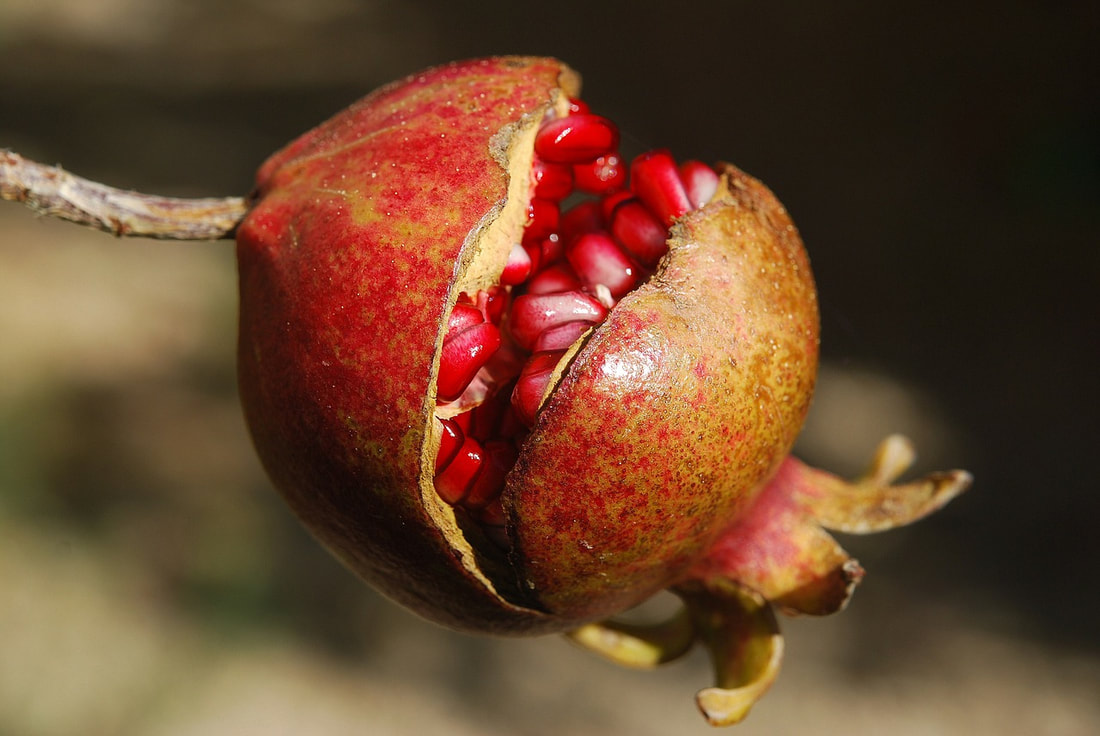
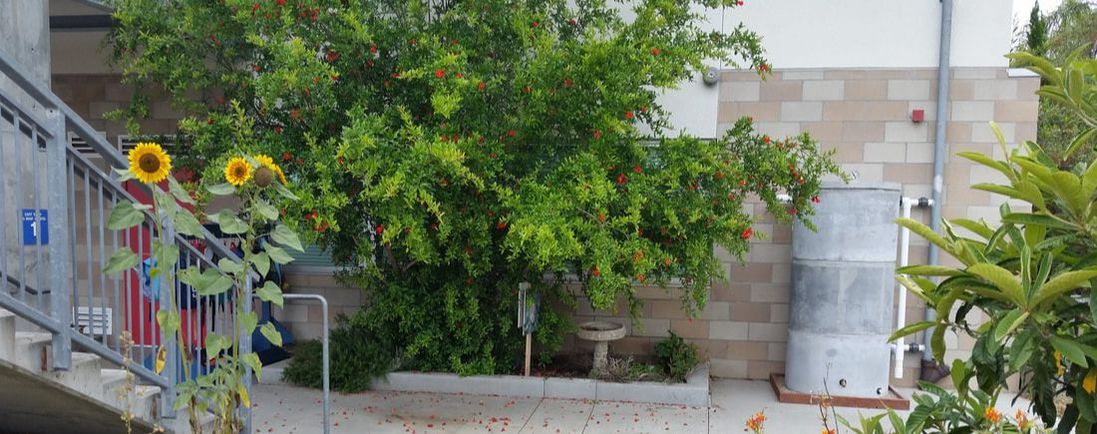
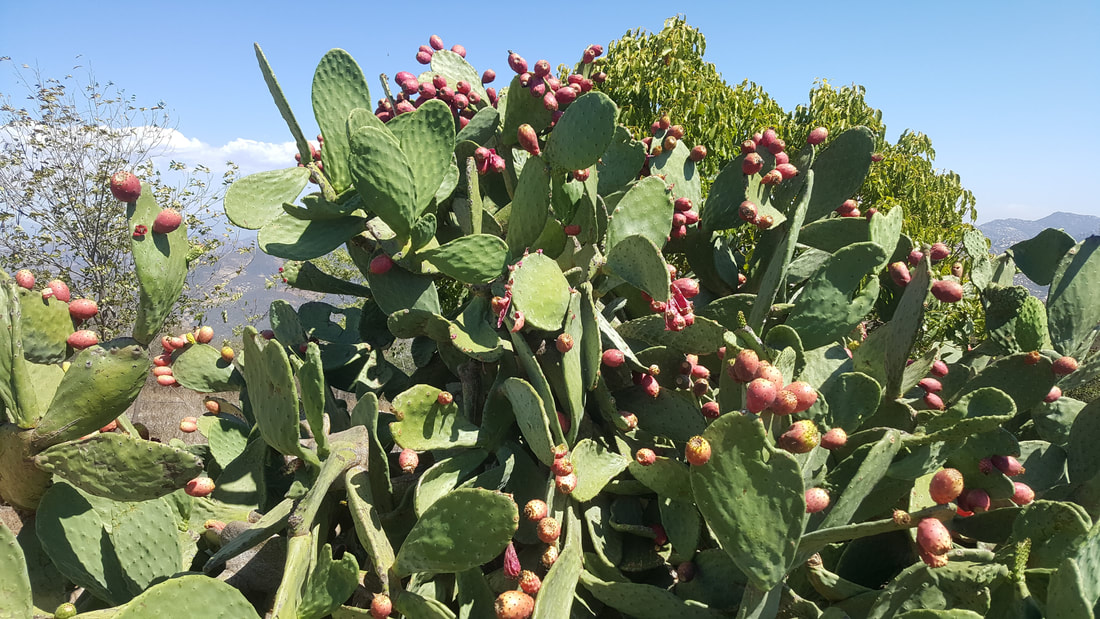
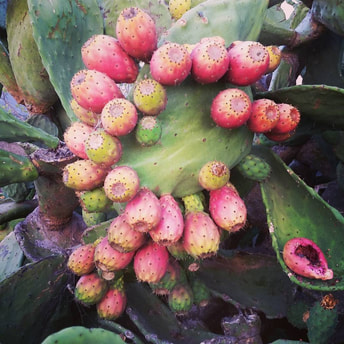
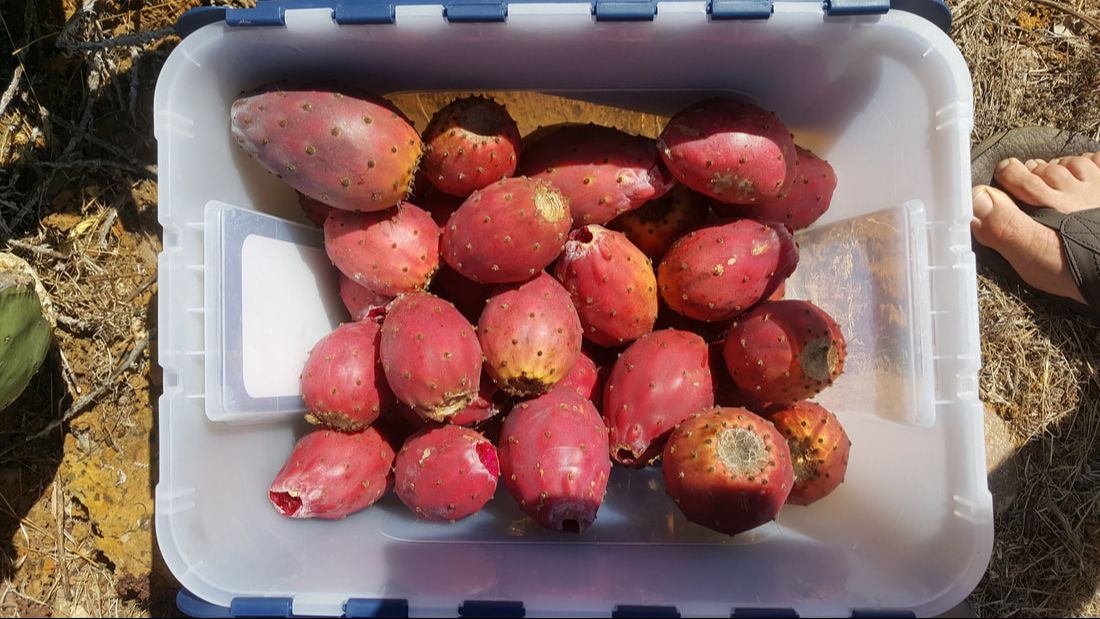
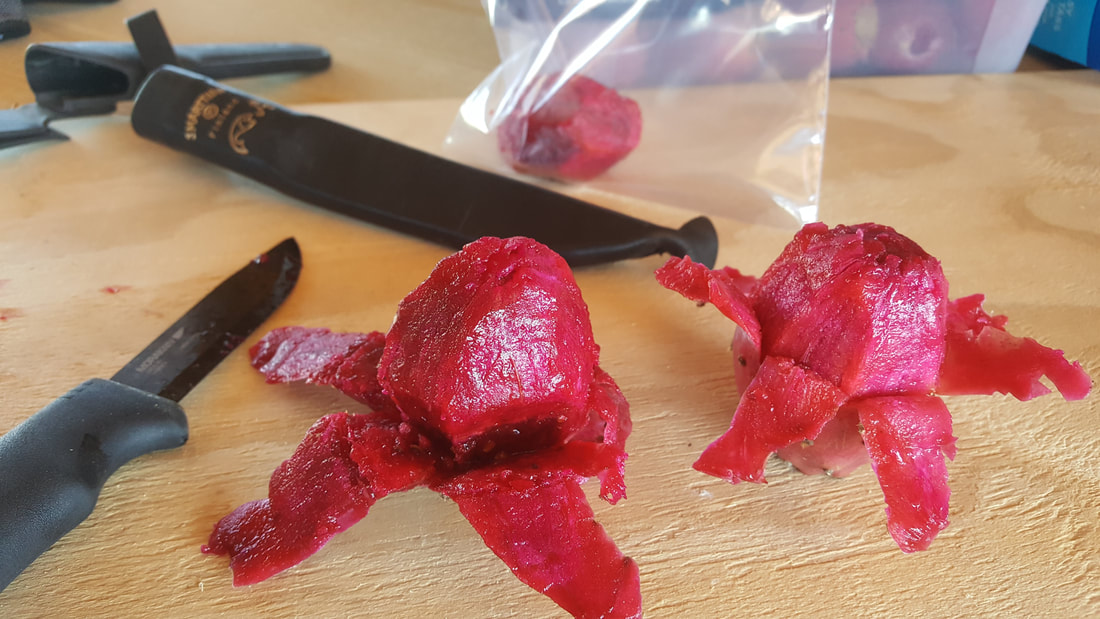

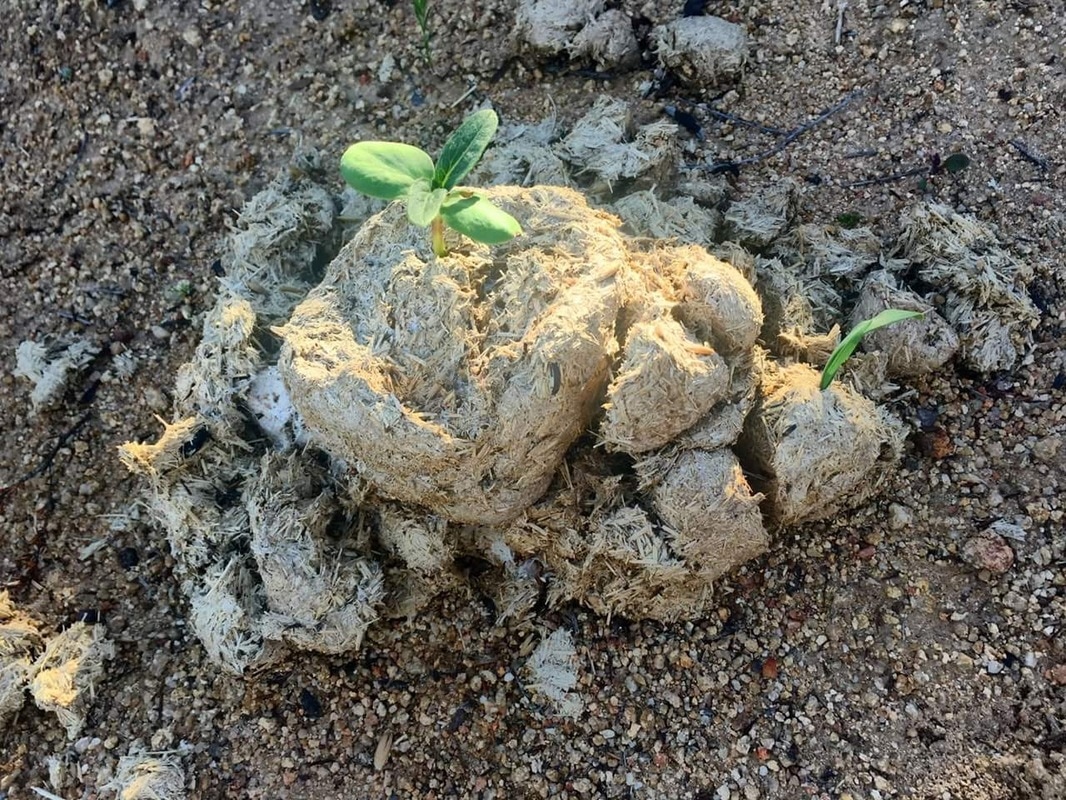
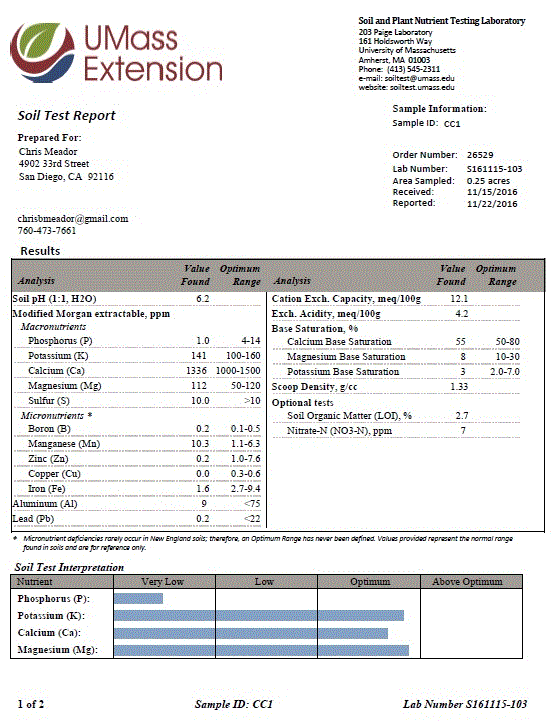
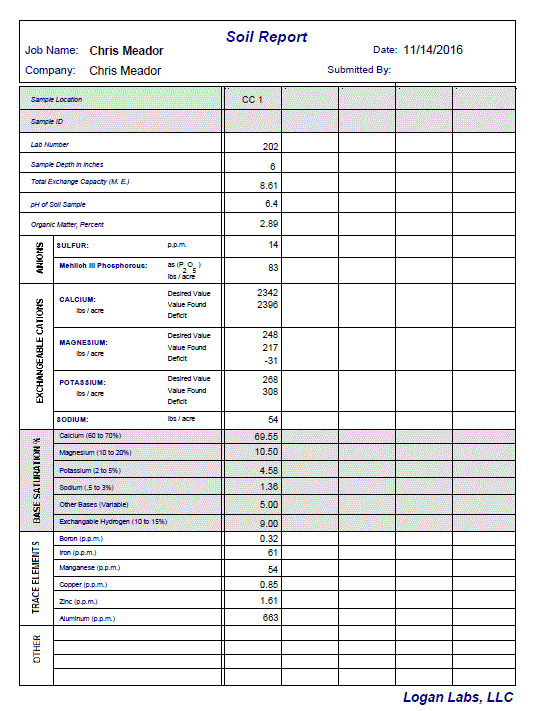
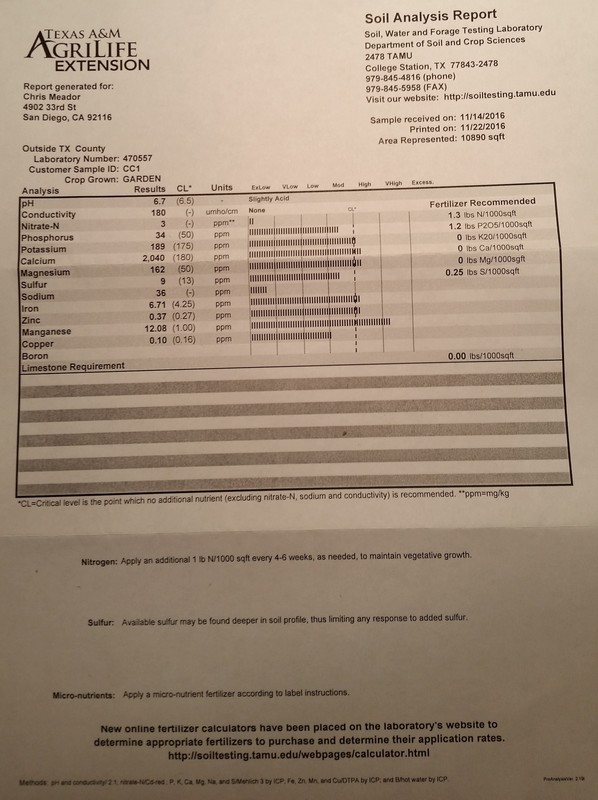
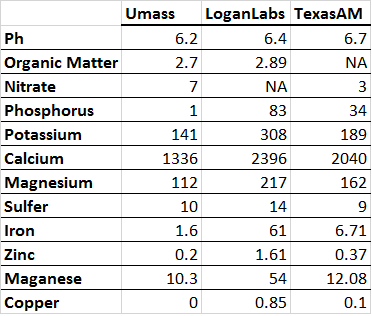
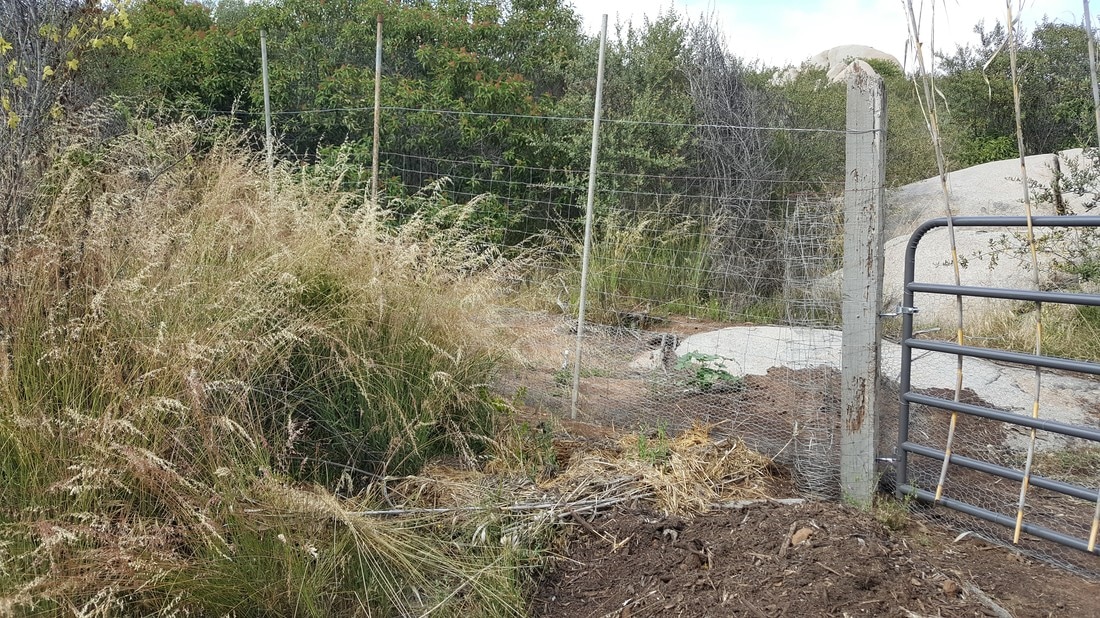
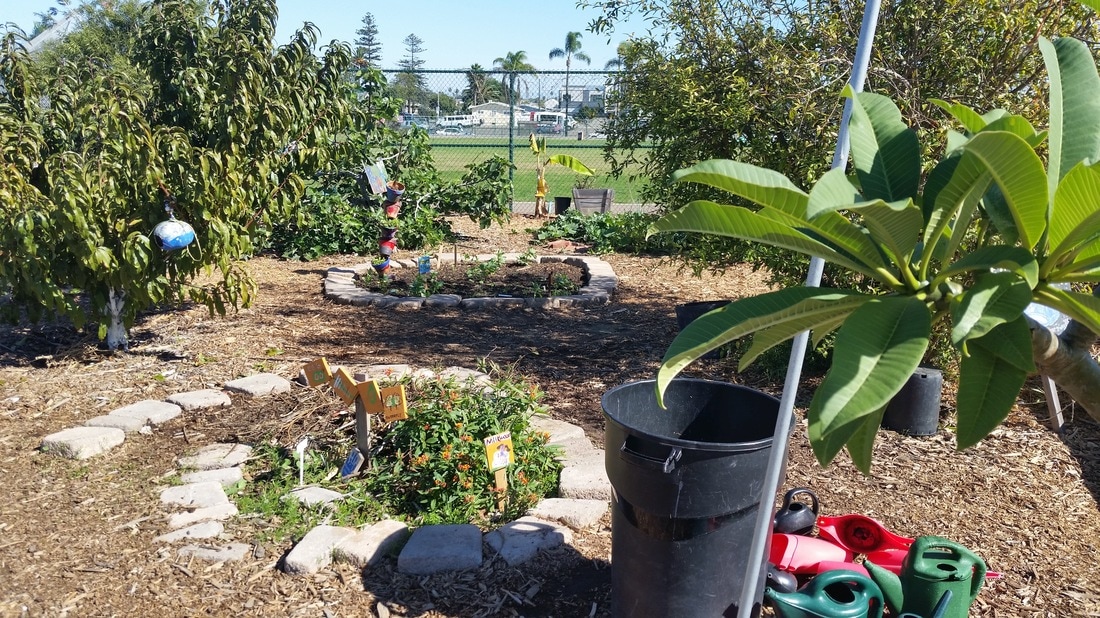

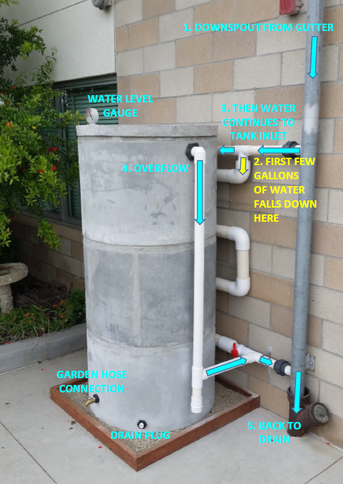

 RSS Feed
RSS Feed